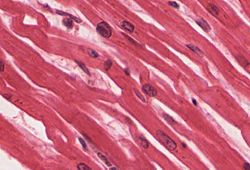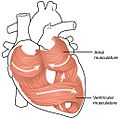Cardiac muscle facts for kids
Quick facts for kids Cardiac muscle |
|
|---|---|
 |
|
| Cardiac muscle | |
 |
|
| Cardiac muscle tissue is only found in the heart | |
| Latin | Textus muscularis striatus cardiacus |
Cardiac muscle is a special type of muscle found only in your heart. It's also called heart muscle. This muscle is super important because it helps your heart pump blood all over your body.
Unlike the muscles you control (like your arm or leg muscles), you can't tell your heart muscle when to beat. It works all by itself, which is why we call it involuntary muscle.
Your heart muscle is made of tiny cells. These cells are arranged in stripes, so we call it striated muscle. The main part of your heart made of this muscle is called the myocardium. It's a thick middle layer of the heart wall. The myocardium is between the outer layer (the epicardium) and the inner layer (the endocardium).
The cells in your heart muscle work together. They squeeze and relax in a perfect rhythm. This action pushes blood out of the heart's upper chambers (the atria) and lower chambers (the ventricles). This blood then travels through your circulatory system to your lungs and the rest of your body. When your heart muscle squeezes, it's called systole.
Heart muscle cells need a constant supply of oxygen and nutrients. Special blood vessels called coronary arteries deliver these directly to the heart muscle. They also take away waste products.
Contents
How Your Heart Muscle Works
The main job of your heart muscle is to squeeze and relax. This action keeps blood moving through your body.
The Heart's Cycle
Your heart works in a steady cycle, beating over and over again. This is called the cardiac cycle. It has two main parts:
- Relaxing and filling: This is when your heart muscle relaxes. It opens up to let blood flow back in. This part is called diastole.
- Squeezing and pumping: This is when your heart muscle squeezes. It pushes blood out to your body. This part is called systole.
After your heart pumps blood out, it quickly relaxes. This allows it to fill up with fresh blood again. A healthy heart needs to fully relax before it can pump strongly again.
Can Heart Muscle Grow Back?
For a long time, scientists thought that heart muscle cells could not grow back if they were damaged. But in 2009, new research showed this might not be true!
Scientists at the Karolinska Institute in Stockholm studied heart muscle samples. They found that new heart muscle cells can actually form. For example, a 4-year-old might replace about 20% of their heart muscle cells each year. Even a 50-year-old can have many new heart muscle cells that grew after they were born. This discovery is very exciting for heart health!
Problems with Heart Muscle
Sometimes, the heart muscle can become unhealthy or weak.
Overworked Heart Muscle
If someone has very high blood pressure (hypertension), their heart muscle might have to work too hard. Over time, this can make the heart muscle bigger and less effective at pumping blood. This condition is called hypertrophy.
Electrical Problems
Your heart has an electrical system that tells the muscle when to beat. If there's a problem with this system, the heart muscle might not beat correctly.
- If the heart beats too slowly, it's called bradycardia. It might not pump enough blood to the body.
- If the heart beats too fast, it's called tachycardia. It might not have enough time to fill with blood before squeezing again.
Blocked Blood Flow
The heart muscle gets its own blood supply through special arteries called coronary arteries. These arteries bring oxygen and nutrients to the heart. If these coronary arteries get blocked, the heart muscle might not get enough blood or oxygen.
If a part of the heart muscle doesn't get oxygen for too long, that part can die. This serious event is called a myocardial infarction, or more commonly, a heart attack.
See also
 In Spanish: Miocardio para niños
In Spanish: Miocardio para niños
Images for kids
-
Intercalated discs are part of the cardiac muscle cell sarcolemma and they contain gap junctions and desmosomes.





